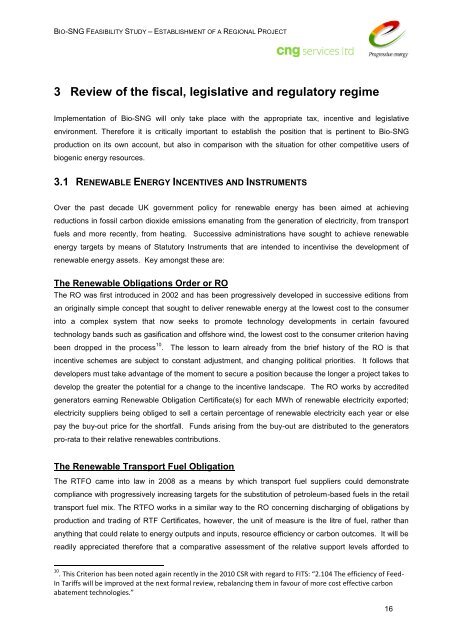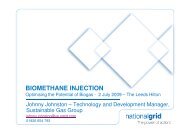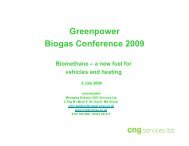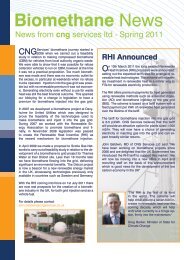Bio-SNG - CNG Services
Bio-SNG - CNG Services
Bio-SNG - CNG Services
Create successful ePaper yourself
Turn your PDF publications into a flip-book with our unique Google optimized e-Paper software.
BIO-<strong>SNG</strong> FEASIBILITY STUDY – ESTABLISHMENT OF A REGIONAL PROJECT3 Review of the fiscal, legislative and regulatory regimeImplementation of <strong>Bio</strong>-<strong>SNG</strong> will only take place with the appropriate tax, incentive and legislativeenvironment. Therefore it is critically important to establish the position that is pertinent to <strong>Bio</strong>-<strong>SNG</strong>production on its own account, but also in comparison with the situation for other competitive users ofbiogenic energy resources.3.1 RENEWABLE ENERGY INCENTIVES AND INSTRUMENTSOver the past decade UK government policy for renewable energy has been aimed at achievingreductions in fossil carbon dioxide emissions emanating from the generation of electricity, from transportfuels and more recently, from heating. Successive administrations have sought to achieve renewableenergy targets by means of Statutory Instruments that are intended to incentivise the development ofrenewable energy assets. Key amongst these are:The Renewable Obligations Order or ROThe RO was first introduced in 2002 and has been progressively developed in successive editions froman originally simple concept that sought to deliver renewable energy at the lowest cost to the consumerinto a complex system that now seeks to promote technology developments in certain favouredtechnology bands such as gasification and offshore wind, the lowest cost to the consumer criterion havingbeen dropped in the process 10 . The lesson to learn already from the brief history of the RO is thatincentive schemes are subject to constant adjustment, and changing political priorities. It follows thatdevelopers must take advantage of the moment to secure a position because the longer a project takes todevelop the greater the potential for a change to the incentive landscape. The RO works by accreditedgenerators earning Renewable Obligation Certificate(s) for each MWh of renewable electricity exported;electricity suppliers being obliged to sell a certain percentage of renewable electricity each year or elsepay the buy-out price for the shortfall. Funds arising from the buy-out are distributed to the generatorspro-rata to their relative renewables contributions.The Renewable Transport Fuel ObligationThe RTFO came into law in 2008 as a means by which transport fuel suppliers could demonstratecompliance with progressively increasing targets for the substitution of petroleum-based fuels in the retailtransport fuel mix. The RTFO works in a similar way to the RO concerning discharging of obligations byproduction and trading of RTF Certificates, however, the unit of measure is the litre of fuel, rather thananything that could relate to energy outputs and inputs, resource efficiency or carbon outcomes. It will bereadily appreciated therefore that a comparative assessment of the relative support levels afforded to10 . This Criterion has been noted again recently in the 2010 CSR with regard to FITS: “2.104 The efficiency of Feed-In Tariffs will be improved at the next formal review, rebalancing them in favour of more cost effective carbonabatement technologies.”16









